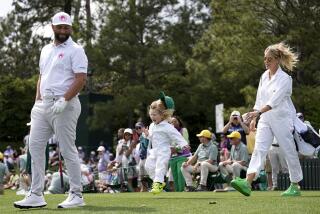Head Injuries From Golf Increasing as More Kids Get Tiger Woods Fever
- Share via
You’ve seen those adorable commercials: Sober-faced 6-year-olds wielding Big Berthas and proclaiming, “I am Tiger Woods.”
Unfortunately, a growing number of kiddies can add the line: “And I just got out of the brain trauma unit.”
Pediatric neurosurgeons across the country are reporting a spate of serious head injuries among children, usually younger than 10, who are learning to play golf--but haven’t yet learned how to do it safely.
So, if you’re one of the legions of parents sending your kid off to golf lessons this summer, take note: Tiger Woods imitations can be a dangerous proposition.
“After Tiger Woods won the [1997] Masters, there was a big interest in golf for kiddies. But there was also an increase in head injuries from golf, too,” says Dr. William Couldwell, chief of neurosurgery at Westchester Medical Center in Westchester, N.Y., an area that is considered the birthplace of American golf. “A lot of our colleagues said they have seen an increase also.”
Couldwell, who reported on the injuries at the annual meeting of the American Assn. of Neurological Surgeons in April, said that in the three months following Woods’ Masters victory, 49 children were admitted to the hospital with head trauma--four of whom were injured by a golf club. During the previous year, there were no admissions for golf club head injuries.
All of the children were between the ages of 6 and 9, and all were struck by a club wielded by another child. In two cases, the club was no less than a driver.
Woods created a sensation in 1997 when he won six of his first nine professional tournaments, including the heralded Masters. According to the National Golf Foundation, golf participation rose 29% last year among players 5 to 17 to 3.3 million players. About one-third of those children are 5 to 11.
*
Golf club head injuries tend to be extremely serious. Of the 49 head trauma cases studied by Couldwell, 13 required surgery, including all four golf club injuries.
“These are not just lumps and bumps,” he said. “These kids required operative interventions. They all had skull fractures. And two were open skull fractures, meaning the brain or bone was exposed. One child almost lost his eye; I had to reconstruct his forehead.”
All the children recovered, but Couldwell added, “I really feel this illustrates that we need adequate supervision for kids playing golf. These clubs can be very dangerous.”
The Professional Golf Assn. long ago established a safety checklist for teaching pros who work with junior golfers. “If children are getting lessons from PGA professionals, they are getting proper safety tips,” said Julius Mason of the PGA.
All four children in the Westchester study were hit in informal situations, such as playing in the yard. However, inexpensive group golf lessons for kids are becoming a popular offering through park and recreation departments, colleges and private sports camps. Any adult who is responsible for a child with a golf club should be familiar with safety guidelines, says Dr. Bruce Kaufman, a pediatric neurosurgeon in St. Louis.
“You want to expand teaching safety rules to the families and siblings of those you are teaching. The ones you are teaching usually know what the club is doing. It’s the friends and siblings who get in the way,” Kaufman says.
*
Anyone teaching children should spend considerable time planning a safe environment, according to the PGA. The first lesson children receive should be about the dangers of misusing a golf club, including the risk of death. The association also recommends that instructors carry whistles to stop unsafe behavior quickly. And, in playing situations where supervision is difficult, children should be required to use only a half swing.
The PGA recommends that children be taught a “Stop-Look-and-Swing” procedure, which includes looking in every direction before any swing--regardless of the situation.
Another good tip includes pairing children off in a buddy system so that one stands behind the other and serves as a spotter for the other.
Other safety rules budding Tigers should observe during practice or play:
* Never swing a golf club in a group setting.
* Swing the club only in designated areas and when all other golfers are in safe positions.
* Be careful when you approach a student who has the club down in the address position--they are not aware of anything around them.
* Never stand in the target line of other students swinging clubs. The club could slip out of their hands or the club head could come off.
* Never go in front of an established hitting line, regardless of the type of ball being used.
* Hold the club at the club head end when the instructor is demonstrating or organizing the class.
* Yell “Fore!” when you hit a ball that might hit someone.
* Cover up when you hear “Fore!” Use hands and arms to protect the head and face.
* Only the person playing the shot should be within the teeing area.
* Never position yourself in the line of a bunker shot. A missed swing could produce a high velocity shot at a short distance that would be impossible to avoid.
* And if you are the parent of a budding golfer, save this story--Tiger Woods is expected to be a star attraction of the U.S. Open, which begins Thursday.
If he wins, look out.
More to Read
Go beyond the scoreboard
Get the latest on L.A.'s teams in the daily Sports Report newsletter.
You may occasionally receive promotional content from the Los Angeles Times.










